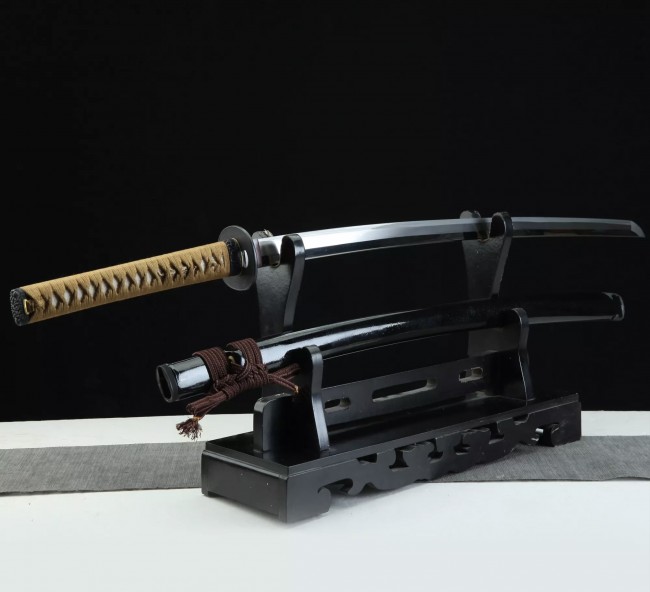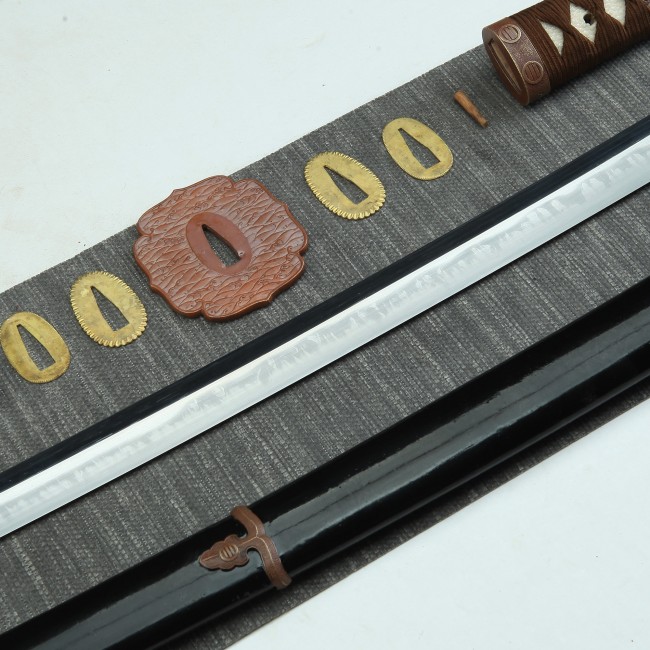Japan is known for its mastery of the art of sword making, and the Japanese Tamahagane steel is one of the most prized materials used in crafting these legendary blades. Tamahagane is a type of steel that is made by the traditional Japanese smelting process, which involves the fusion of iron sand and charcoal. In this blog post, we will explore the history and features of Japanese Tamahagane steel, as well as the process of making a Japanese Tamahagane katana sword.

Tamahagane steel has a long and storied history in Japan. The steel was originally used to make farming tools and weapons during the Yayoi period (300 BC – 300 AD). The steel was then adopted for use in sword making during the Heian period (794–1185), where it became an integral part of the samurai culture.
The Tamahagane steel was traditionally made by the tatara method, which involves the smelting of iron sand and charcoal in a clay furnace called a tatara. The tatara furnace is heated to over 1,200 degrees Celsius, and the iron sand and charcoal are added in alternating layers. The heat from the furnace causes the iron sand to melt and combine with the carbon from the charcoal to form Tamahagane steel.
Japanese Tamahagane steel is known for its unique features that make it ideal for sword making. The steel has a high carbon content, which gives it excellent edge retention and toughness. It also has a low impurity content, which makes it easier to work with and gives it a consistent and uniform grain structure.
Another unique feature of Tamahagane steel is its variable carbon content. The steel has a higher carbon content near the edge of the blade, which makes it harder and more durable. The carbon content is lower in the middle of the blade, which makes it more flexible and resilient.

Making a Japanese Tamahagane katana sword is a time-consuming and intricate process that requires a high level of skill and expertise. The process can take several months to complete, and involves the following steps:
The Japanese Tamahagane steel is a unique and prized material that has been used in sword making for centuries. The steel has a high carbon content, low impurity content, and a variable carbon content, making it ideal for creating sharp and durable blades. The process of making a Japanese Tamahagane katana sword is a time-consuming and intricate process that requires a high level of skill and expertise. Despite the modern advances in steel production, the traditional
Tamahagane steel is a type of traditional Japanese steel that is highly regarded for its exceptional quality and unique properties. It is made using a complex and labor-intensive process that involves smelting iron sand and charcoal in a clay furnace for several days, followed by forging and hammering the resulting material into shape.
One reason why tamahagane steel is so expensive is due to the scarcity of its raw materials, particularly the high-quality iron sand used in its production. This type of iron sand can only be found in certain regions of Japan, and the process of extracting and refining it is time-consuming and costly.
Moreover, the smelting process for tamahagane steel is extremely difficult and requires a great deal of skill and expertise. It is also a time-consuming process that can take several days to complete. As a result, the labor costs involved in producing tamahagane steel are high, which drives up its price.
Additionally, the demand for tamahagane steel is high, particularly among collectors and enthusiasts who appreciate its unique properties and historical significance. This demand, coupled with the limited supply of tamahagane steel, further contributes to its high price.
In conclusion, the high cost of tamahagane steel is due to a combination of factors, including the scarcity of its raw materials, the difficulty and labor intensity of its production process, and the high demand for this unique and highly prized material.
Yes, tamahagane steel is considered to be one of the best materials for making high-quality swords. This is because tamahagane steel possesses several unique properties that make it well-suited for use in sword-making.
First and foremost, tamahagane steel is known for its exceptional toughness, hardness, and durability. This is due to the fact that it is made using a combination of high-quality iron sand and charcoal, which results in a steel that is both strong and resilient.
In addition, tamahagane steel also possesses a unique grain structure that gives it a distinctive and beautiful appearance. This grain structure is created during the forging and hammering process, and it is one of the key characteristics that sets tamahagane steel apart from other types of steel.
Finally, tamahagane steel is also highly regarded for its ability to hold a sharp edge for extended periods of time. This is due to the fact that it contains a high concentration of carbon, which helps to enhance its cutting ability and edge retention.
In conclusion, tamahagane steel is an excellent choice for making swords due to its exceptional toughness, hardness, durability, unique grain structure, and ability to hold a sharp edge. These properties, combined with the skill and expertise of the sword-maker, can result in a truly exceptional and highly prized weapon.